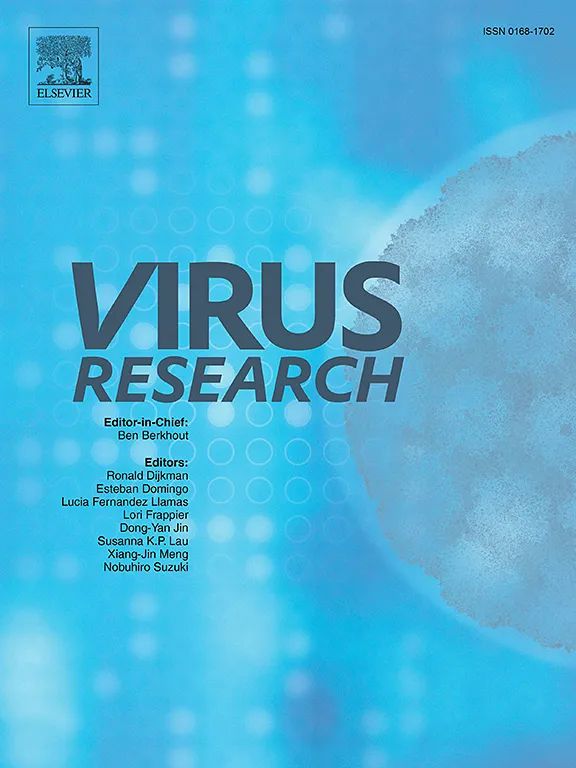糖皮质激素受体和特异性蛋白 1(Sp1)或 Sp3 可反式激活 HSV-1 ICP0 启动子序列,但一种富含 GC 结合力的抗生素 Mithramycin A 会影响潜伏期的再激活。
IF 2.5
4区 医学
Q3 VIROLOGY
引用次数: 0
摘要
糖皮质激素受体(GR)的激活会增强人类α-疱疹病毒1(HSV-1)的复制,并促使其从潜伏期重新活化。此外,GR 和类克鲁珀尔因子 15(KLF15)还能协同反式激活顺式调节模块(CRMs),从而驱动感染细胞蛋白 0(ICP0)、ICP4 和 ICP27 的表达。KLF 和特异性蛋白(Sp)家族成员结合富含 GC 或 C 的序列,属于同一超家族转录因子。基于这些观察结果,我们推测跨越 ICP0 启动子的 CRMs 会被 GR 和 Sp1 或 Sp3 转激活。在小鼠神经母细胞瘤细胞(Neuro-2A)中,CRM-A(-800至-635)、CRM-B(-485至-635)和CRM-D(-232至-24)被GR、DEX和Sp1或Sp3显著转活,而CRM-C则没有。Sp1/Sp3结合位点的突变对CRM-A和CRM-B的转激活很重要。染色质免疫沉淀研究显示,当Sp1或Sp3过度表达时,GR占据ICP0启动子序列的水平明显升高,这表明这些转录因子将GR招募到ICP0 CRM序列上。Mithramycin A 是一种抗生素,能优先结合富含 GC 的 DNA 并损害 Sp1/Sp3 依赖性转录活化,它还能减少潜伏感染 HSV-1 的小鼠从潜伏期重新激活病毒脱落。这些研究表明,GR 和某些应激诱导的细胞转录因子会优先结合富含 GC 的 DNA,从而刺激 HSV-1 基因的表达和潜伏感染小鼠三叉神经节中潜伏期病毒的重新激活。本文章由计算机程序翻译,如有差异,请以英文原文为准。
Glucocorticoid receptor and specificity protein 1 (Sp1) or Sp3 transactivate HSV-1 ICP0 promoter sequences but a GC-rich binding antibiotic, Mithramycin A, impairs reactivation from latency
Glucocorticoid receptor (GR) activation enhances Human alpha-herpes virus 1 (HSV-1) replication and explant-induced reactivation from latency. Furthermore, GR and Krüppel-like factor 15 (KLF15) cooperatively transactivate cis-regulatory modules (CRMs) that drive expression of infected cell protein 0 (ICP0), ICP4, and ICP27. KLF and specificity protein (Sp) family members bind GC-rich or C-rich sequences and belong to the same super-family of transcription factors. Based on these observations, we hypothesized CRMs spanning the ICP0 promoter are transactivated by GR and Sp1 or Sp3. CRM-A (-800 to -635), CRM-B (-485 to -635), and CRM-D (-232 to -24), but not CRM-C, were significantly transactivated by GR, DEX, and Sp1 or Sp3 in mouse neuroblastoma cells (Neuro-2A). Mutagenesis of Sp1/Sp3 binding sites were important for transactivation of CRM-A and CRM-B. Chromatin immunoprecipitation studies revealed significantly higher levels of GR occupied ICP0 promoter sequences when Sp1 or Sp3 was over-expressed suggesting these transcriptions factors recruit GR to ICP0 CRM sequences. Mithramycin A, an antibiotic that preferentially binds GC-rich DNA and impairs Sp1/Sp3 dependent transactivation and reduced virus shedding during reactivation from latency in mice latently infected with HSV-1. These studies indicate GR and certain stress-induced cellular transcription factors preferentially bind GC rich DNA, which stimulates HSV-1 gene expression and reactivation from latency in trigeminal ganglia of latently infected mice.
求助全文
通过发布文献求助,成功后即可免费获取论文全文。
去求助
来源期刊

Virus research
医学-病毒学
CiteScore
9.50
自引率
2.00%
发文量
239
审稿时长
43 days
期刊介绍:
Virus Research provides a means of fast publication for original papers on fundamental research in virology. Contributions on new developments concerning virus structure, replication, pathogenesis and evolution are encouraged. These include reports describing virus morphology, the function and antigenic analysis of virus structural components, virus genome structure and expression, analysis on virus replication processes, virus evolution in connection with antiviral interventions, effects of viruses on their host cells, particularly on the immune system, and the pathogenesis of virus infections, including oncogene activation and transduction.
 求助内容:
求助内容: 应助结果提醒方式:
应助结果提醒方式:


